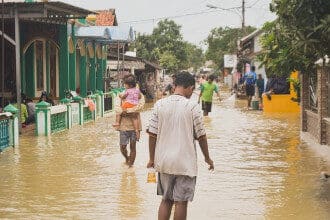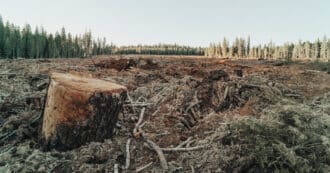By Harry Cooper – Deforestation has destroyed hundreds of habitats, put many species at risk of extinction, contributed to climate change, and caused wide-spread and tragic environmental degradation. Activists everywhere have tried to stop deforestation by educating people, protesting, and even sitting in trees to prevent them from being cut down.
The Politics of Trees
So if deforestation is so bad, and so many people are advocating to stop it, why are people still cutting down trees? The short answer is money, but the reality of the situation is a little more complicated.
Economic Growth
The money motivators of deforestation can really be seen when we look at just how much of it is motivated by economic growth. Only around 23% of forest loss can be attributed to wildfires. The rest is estimated to be attributed to deforestation with 27% cleared for permanent commodity production such as mining sites and agriculture, and logging industry operations accounting for the other 50%.
This shows just how much of deforestation is caused by industries seeking to make a profit. And while it might be easy to point fingers at the businesses and countries that seek to gain from deforestation, the larger scope of the situation is not as simple.
Developing Countries
When we look at where the majority of deforestation is happening in the world we can start to understand why deforestation is so widespread. Deforestation mainly occurs in underdeveloped tropical countries in Africa, South America, and Southeast Asia. These countries are less developed economically and often rely on the economic growth that comes from deforestation, despite the negative impacts on the environment.
These underdeveloped countries rely on land clearance and industries such as logging, the pulp and paper industry, and palm oil production for their already struggling economies. While logging and development may cause deforestation, many countries in the developing world see this as a necessary evil.
A Complicated Controversy
While countries may cite the economic benefits of deforestation in order to justify it, this economic productivity is only short term. Deforestation has been proven to have many economic downsides, such as contributing to climate change and destroying the homes and jobs of people who live in the forest. This has made deforestation both a nuisance and a necessity for the economies and people of developing nations.
With both economic benefits and drawbacks, deforestation has become controversial politically, making it hard to do anything about it. However, international treaties and activist groups have been relentless in their attempts to stop deforestation from destroying anymore of our dwindling forests.
International Action
Deforestation has been a rising issue for some time now. It has gained so much prominence that it has warranted the attention of one of the highest bodies of international authority, the UN.
Global Forest Pledge
The United Nations has discussed and signed agreements related to deforestation in the past, but those goals were reestablished last November in the United Nations Climate Change Conference in Glasgow. 141 different countries signed a pledge to stop deforestation, with the hope of completely ending it by 2030.
This pledge was built on past agreements such as the New York Declaration of Forest Goals in 2014. The new pledge reiterated ambitious goals of ending deforestation in the near future through global cooperation and international action.
The COP26 deforestation pledge highlights the importance of promoting sustainable development. The countries that signed on agreed to utilize international financial institutions to help struggling economies not just grow, but grow sustainably.
By promoting sustainable growth of economies, the countries of the United Nations are attempting to help economically struggling countries grow while developing sustainable agriculture and sustainable forestry. These more sustainable methods could help counties gain the economic benefits that they would get through deforestation without harming their forests or their population.
Sustainable Forest Management
Many people have began fulfilling the pledges to achieve more sustainable forestry practices around the world. These sustainable forestry practices can help extract natural resources from trees without harming the larger environment.
What is Sustainable Forestry?
It may be hard to conceive how we could cut down enough trees to meet the world logging and agriculture demands without harming the forests they come from, but it may not be as impossible as it seems. Many simple sustainable forestry techniques are capable of helping solve deforestation, while still providing us with wood and other forest resources.
In a landscape completely untouched by humans trees still die and fall down as a natural function of an ecosystem; sustainable forestry aims to mimic the natural falling of trees in order to cause minimal disruption to the forest ecosystem. Since trees are a renewable resource, by respecting forest ecosystems with sustainable forestry, logging industries can create a balance between wildlife, local communities, and wood production.
Challenges to Sustainable Forestry and Illegal Logging
Sustainable forestry has proven to be profitable and healthier to the environment than traditional forest clearing. However, even as countries start to implement sustainable forestry laws, there are still people who are finding ways to cut down trees illegally.
Illegal logging undermines the efforts and pledges to stop deforestation and has proven to be a nuisance for governments and activists trying to protect the environment. Illegal logging has also caused some serious economic harm, it is estimated that countries struggling with illegal logging annually lose around ten billion dollars a year due to illegal deforestation.
Action to Stop Deforestation
As sustainable forestry and environmental consciousness have become more widespread in recent years, deforestation has decreased. However, illegal logging and unregulated industries still threaten the Earth’s forests with deforestation. Thankfully there are many organizations that are still adamant about finding a solution to deforestation once and for all.
Indigenous Communities
Deforestation is very strongly associated with indigenous rights, as many of the rural communities affected by deforestation are made up of indigenous peoples. This has made indigenous rights advocacy and deforestation activism often go hand and hand. Organizations such as Amazon Watch work to empower native communities through an environmental justice lens to move people towards emboldening native rights and stopping deforestation at the same time.
Education
One of the best ways to mobilize people to act against any social problem is to educate people on the problem, why it needs to be solved, and how to solve it. Organizations such as the Sustainable Forestry Initiative and the Forest Stewardship Council work to educate children and adults about the impacts of deforestation and how they can make sustainable choices in their own lives to help work towards ending deforestation.
Be Proactive to Stop Deforestation
Education and empowerment are great ways to move people to care about issues. But sometimes the best way to deal with problems, especially pressing ones such as deforestation, is to act.
Organizations such as the Rainforest Alliance and Trees for the Future do work in the field to help restore the world’s forests and stop deforestation. By planting new trees and teaching local farmers more sustainable farming and forestry techniques activist organizations are helping to create a more tree friendly world, where humans and forests can live together.
The Future of Deforestation
For the past few decades people everywhere have been fighting deforestation in many different ways, and more people are being mobilized to act everyday. But what does this mean for the future of our forests?
While deforestation rates were increasing throughout the 1990s and 2000s, recent studies have shown that in the past decade deforestation has started to decrease globally. This shows that activism, government action, and implementation of sustainable techniques can have a meaningful impact on ending deforestation.
This statistic is cause for some optimism and hope for the world’s forests. However, it does not mean that deforestation will soon be a thing of the past.
While deforestation is decreasing overall, it is increasing in several parts of the world. Places such as the Amazon rainforest continue to see increasing logging and land clearing.
Thus, while many countries are making strides to stop deforestation, there is still a lot of work to be done, but with continued action and advocacy we can help stop deforestation and save our world’s forests.
Religious Approaches to Stopping Deforestation
Religious people around the world are coming together to “protect the world’s ‘sacred’ rainforests” as an article on Mongabay describes. In June 2017, leaders from diverse faith traditions came together in solidarity with indigenous people from five tropical countries to from the Interfaith Rainforest Initiative (IRI) and protect the world’s last great rainforests.
Joe Corcoran, IRI program manager with UNEP, the United Nations Environment Programme explains that “This isn’t about churches planting trees…We want to say clearly and definitively to world leaders: religious leaders take this issue of forests and climate very seriously, and they are going to be holding public officials accountable to make sure these issues are addressed.” The tone of these comments and others seen throughout this article is that encouraging small-scale sustainability is a start, but we really need to see religious leaders engendering political change to protect forests on a large-scale.
The call for religious leaders to have a political influence can been seen clearly in the words of Rev. Fletcher Harper, an Episcopal priest and the executive director of GreenFaith, a U.S.-based interfaith environmental coalition.
“Does this effort stand a chance?” he asked. “I think it does. But around the world, that question is still up in the air. Religious groups have more potential for political influence than they have yet deployed. But it’s going to take a level of education, resolve and scale of action that is altogether larger and different than we’ve seen so far.”
* Featured image source










Hi there,
My name is Lewis and I am emailing you from an Intermediate School in Auckland. My class is researching how humans share the planet with all kinds of creatures and how ecosystems impact our lives. For an individual project I have chosen to look into deforestation. It is something that really interests me because orangutans are my absolute favorite animal and I want to protect their habitat.
To assist me in my project I was hoping you would be able to answer some questions about deforestation.
What are the effects of deforestation on orangutans and what can be done to help their survival?
What substitutes can be found for wood and what are their uses?
I would really appreciate any help you are able to give me.
Thanks in advance,
Lewis Martin
Lewis, thank you for your comment and your interest in our blog. Unfortunately we are unable to provide information beyond that which is contained in the above blog post and several more of our blog posts on deforestation, which can be found here: https://interfaithsustain.com/?s=deforestation.
We wish you the best of luck with your project!